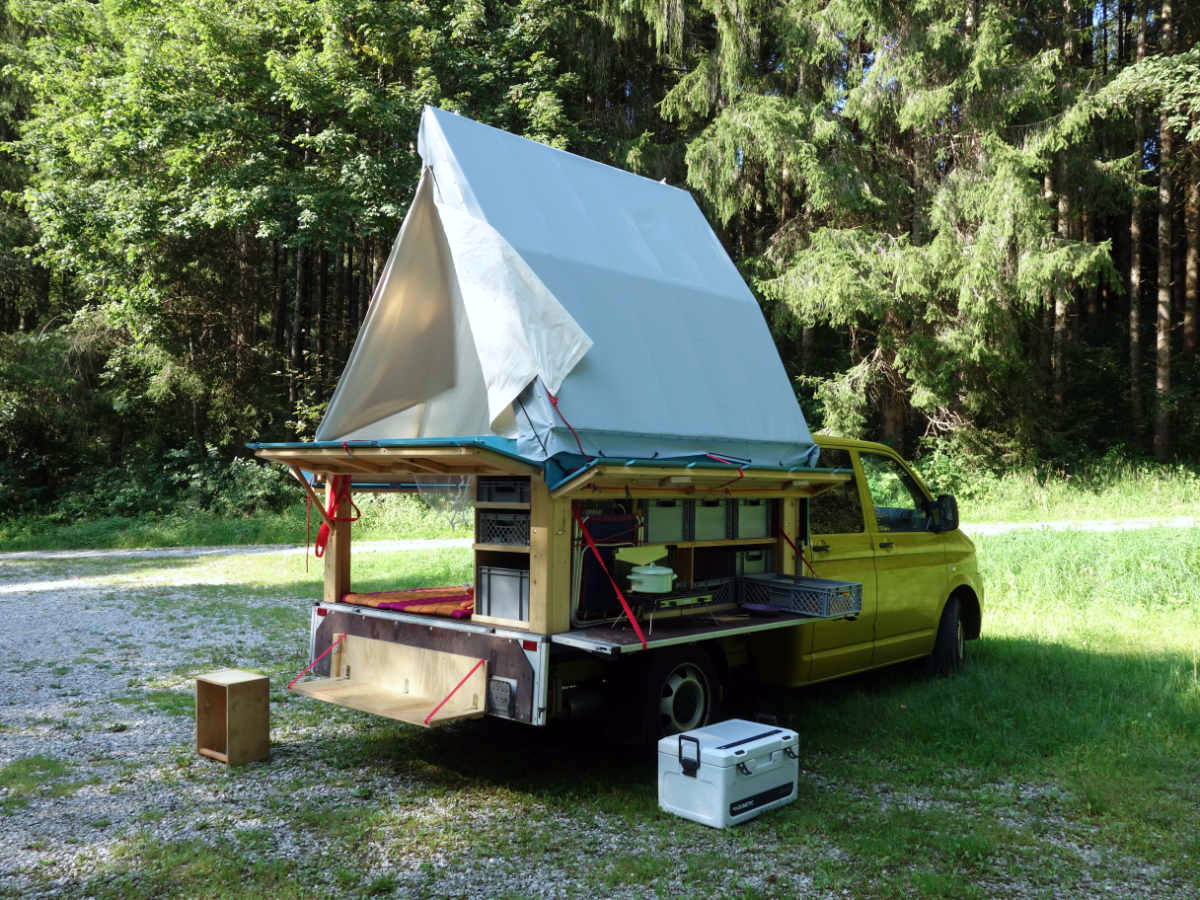










für / for: privat
Leistung / service: Entwurf, Ausführung / design, construction
Fotos / images: Andree Weißert
Ziemlich genau 20 Jahre und geschätzt 10 Fahrzeuge nach dem Kauf meines ersten Autos, ein VW T3 DOKA, Baujahr 1985 haben wir und wieder einen VW DOKA gekauft - T5.
DOKA steht für Doppelkabine. Das heißt: Ein Pritschenfahrzeug mit zwei Sitzreihen, fünf Sitzplätzen - ein tolles Bau- und ein perfektes Familienfahrzeug. Wenn man die Ladefläche mit einer Campingoption versieht…
Im Alltag ein unauffälliger VW-Bus, kaum länger als ein normaler Kombi. Alles was man im Alltag transportieren muss, geht da sehr entspannt rein - und noch viel mehr. Die großzügige Ladefläche ist ausgezeichnet geeignet um eine Baustelle zu beschicken oder einen kleinen Umzug zu machen. Doch seine einzigartigen Qualitäten offenbart der Bus, sobald er sich an einem schönen Ort zum campieren entfaltet. Innerhalb von wenigen Minuten wird aus dem schlichten Volumen ein luftiger Zeltraum, ein Schlafplatz für vier, eine Outdoorküche, ein Zentrum für sommerliche Draußenaktivitäten, Eine weit sichtbare Laterne bei Nacht.
Die Konstruktion hat an der bretonischen Küste bereits Stürmen und Starkregen widerstanden.
Die Dachhaut besteht aus einer Polypropylen-Plane. Diese ist im Gegensatz zu herkömmlichen LKW-Planen frei von Weichmachern, voll recyclebar und hat keine unangenehme Geruchsentwicklung. Der Zeltstoff ist ein imprägniertes Bauwolltuch, welches durch die Steilheit der Flächen wunderbar dem Regen stand hält und für ein sehr angenehmes Raumklima sorgt. Die weitere Konstruktion besteht aus Fichtenholz und Bausperrholz. Nicht nur die Zeltkonstruktion, auch der Holzbau ist so gefügt, das er in wenigen Minuten komplett demontierbar ist. Beim TÜV ist das Fahrzeug nun als “geschlossener Kasten in Holz“ eingetragen.
Ja, nun beschreibe ich hier einen Camper aus Holz und Baumwolle und recyclebarem Materialien und man stelle sich das schöne Leben vor - so schön, und frei und draußen und in der Natur, die wir mit unseren Fahrzeugen und unserer Reisewut und unseren greengewashten Lebensentwürfen Stück um Stück filetieren und diskutieren am Lagerfeuer die Verkehrswende.
Das Paradox ist unser ständiger Begleiter - und unser Lehrmeister.
Was wir hier gebaut haben, ist ein plastikfreier Camper, der mit einem nostalgischem Motiv als eine Alternative oder Kritik an der Welt von Decatlon, Hymer und anderen Jogurtbechervarianten des “alternativen Reisen“ verstanden werden kann. Eine Selbstkritik beinhaltet es allerdings nicht.
Wie werden wir in Zukunft reisen? Und wann fangen wir mit der Zukunft an?
english text:
Almost exactly 20 years and estimated 10 vehicles after buying my first car, a VW T3 DOKA, built in 1985, we bought another VW DOKA - T5.
DOKA stands for double cabin. That means: A platform vehicle with two rows of seats, five seats - a great construction vehicle and a perfect family vehicle. If you provide the loading area with a camping option...
In everyday life an inconspicuous VW bus, hardly longer than a normal station wagon. Everything you have to transport in everyday life goes in there very relaxed - and much more. The spacious loading area is ideal for loading a construction site or making a small move. But the bus reveals its unique qualities as soon as it unfolds in a nice place to camp. Within a few minutes, the simple volume becomes an airy tent room, a place to sleep for four, an outdoor kitchen, a center for summer outdoor activities, a lantern visible from afar at night.
The construction has already withstood storms and heavy rain on the Brittany coast.
The roof skin consists of a polypropylene tarpaulin. In contrast to conventional truck tarpaulins, this is free of plasticizers, fully recyclable and has no unpleasant odor development. The tent fabric is an impregnated cotton cloth, which, due to the steepness of the surfaces, withstands the rain wonderfully and ensures a very pleasant indoor climate. The further construction consists of spruce wood and plywood. Not only the tent construction, but also the wooden construction is assembled in such a way that it can be completely dismantled in a few minutes. The vehicle is now registered with the TÜV as a "closed box in wood".
Yes, now I am describing a camper made of wood and cotton and recyclable materials and you can imagine the beautiful life - so beautiful, and free and outside and in nature, that we with our vehicles and our travel craze and our green-washed life plans piece around Fillet pieces and discuss the traffic turnaround around the campfire.
The paradox is our constant companion - and our teacher.
What we have built here is a plastic-free camper that can be understood with a nostalgic motif as an alternative or critique of the world of Decatlon, Hymer and other yogurt cup variants of "alternative travel". However, it does not include self-criticism.
How will we travel in the future? And when do we start with the future?